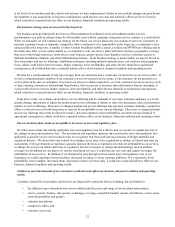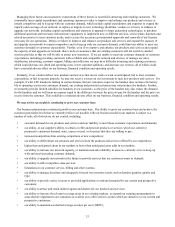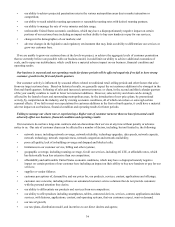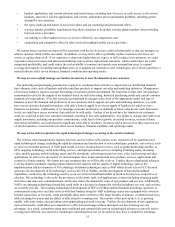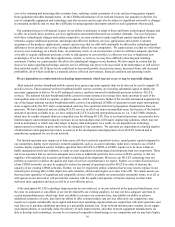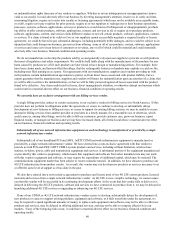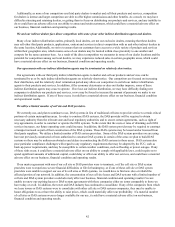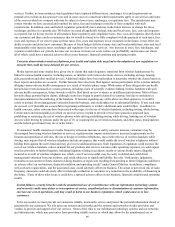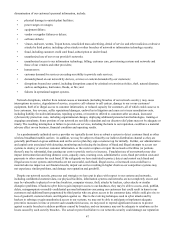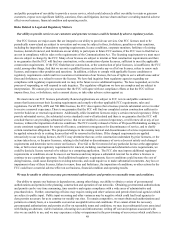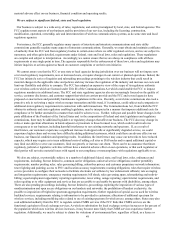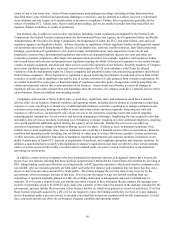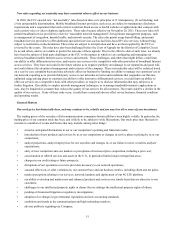Metro PCS 2011 Annual Report Download - page 53
Download and view the complete annual report
Please find page 53 of the 2011 Metro PCS annual report below. You can navigate through the pages in the report by either clicking on the pages listed below, or by using the keyword search tool below to find specific information within the annual report.42
Additionally, as more of our competitors use third party dealers to market and sell their products and services, competition
for dealers is intense and larger competitors are able to offer higher commissions and other benefits. As a result, we may have
difficulty attracting and retaining dealers, or getting them to focus on distributing our products and services, and any inability to
do so could have an adverse effect on our ability to attract and retain customers, which could have a material adverse effect on
our business, financial condition and operating results.
We and our indirect dealers face direct competition with some of our other indirect distribution agents and dealers.
Many of our indirect distribution outlets, primarily local dealers, are not our exclusive dealers, meaning that these dealers
may sell other third party products, applications, content and services in direct competition with us and other indirect dealers in
the same location. Additionally, we strive to ensure that our customers have access to a wide variety of products and services
within their geographic area, which means some of our dealers may be located within close proximity to one another and
compete for the same customer base. As a result of the direct competition we encounter in some of our dealer locations and the
potential for competition among our local dealers, we may experience reduced sales in certain geographic areas, which could
have a material adverse effect on our business, financial condition and operating results.
Our agreements with our indirect distribution agents may be terminated on relatively short notice.
Our agreements with our third party indirect distribution agents to market and sell our products and services can be
terminated by us or by such indirect distribution agents on relatively short notice. Our competitors are focused on increasing
their distribution, and the relatively short termination period may allow our competitors to switch our indirect distribution
agents to their products and services. In addition, if the economy deteriorates or does not further improve, some of these
indirect distribution agents may cease to operate. If we lose our indirect distribution, we may have difficulty finding new
companies to distribute our products and services, or we may be forced to increase the amount of payments we make to our
indirect distribution agents. If any of these occur, it could have a material adverse effect on our business, financial condition
and operational results.
We utilize a limited number of cell site and DAS providers.
We currently use, and plan to continue to use, DAS systems in lieu of traditional cell sites to provide service to certain critical
portions of certain metropolitan areas. In order to construct DAS systems, the DAS provider will be required to obtain
necessary authority from the relevant state and local regulatory authorities and to secure certain agreements, such as right of
way agreements, in order to construct or operate the DAS systems. To the extent that the costs or rates of obtaining such DAS
services increases, our future operating costs could increase. In addition, the DAS system provider may be required to construct
a transport network as part of their construction of the DAS systems. These DAS systems may be leased and/or licensed from
third party suppliers. We utilize a limited number of DAS system providers. Some of the DAS system providers we are using
have not previously constructed or been authorized to construct DAS systems in certain of the areas we plan to build DAS
systems so there may be unforeseen obstacles and delays in constructing the DAS systems in those areas. DAS systems also
pose particular compliance challenges with regard to any regulatory requirements that may be adopted by the FCC, such as
back-up power requirements, and may be susceptible to certain weather conditions, such as flooding or power outages. If any
of these risks occur, it could have a material adverse effect on our ability to comply with applicable laws, could require us to
spend significant amounts of additional capital, could delay or affect our ability to offer our services, and could have a material
adverse effect on our business, financial condition and operating results.
If our master agreement with one of our cell site or DAS providers were to terminate, or if the cell site or DAS system
providers were to experience severe financial difficulties or file for bankruptcy, or if one of these cell site or DAS system
providers were unable to support our use of its cell sites or DAS systems, we would have to find new sites or rebuild the
affected portion of our network. In addition, the concentration of our cell site leases and DAS systems with a limited number of
cell site and DAS system providers could adversely affect our business, financial condition and operating results if we are
unable to renew our expiring leases or DAS system agreements with these companies either on terms comparable to those we
have today or at all. In addition, the tower and DAS industry has continued to consolidate. If any of the companies from which
we lease towers or DAS systems were to consolidate with other cell site or DAS systems companies, they may be unable to
honor obligations to us or have the ability to raise prices, which could materially affect our profitability. If a material number
of cell sites or DAS systems were no longer available for our use, it could have a material adverse effect on our business,
financial condition and operating results.


